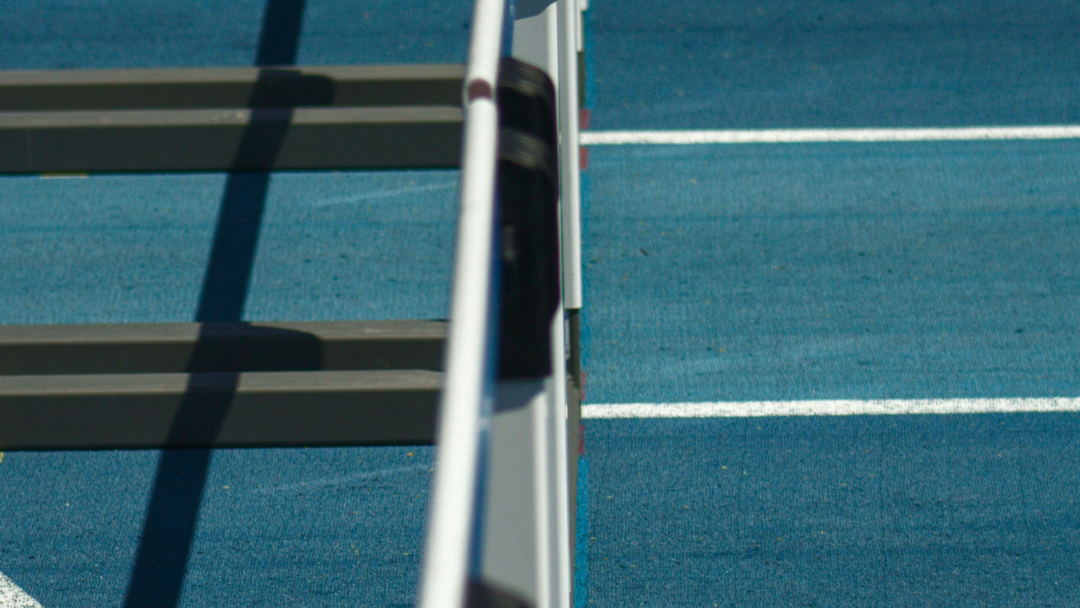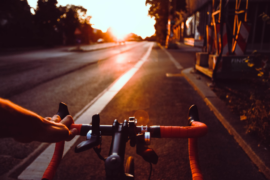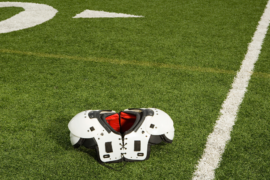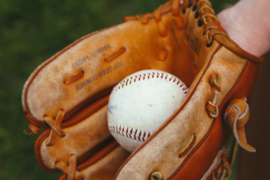What happens when the body fails us?
In 2012, at eighteen I clipped the fourth hurdle in the state qualifying 300-meter hurdle race and fell. I couldn’t finish, either from pain or rage, or a combination of the two, and walked off the track with blood dripping into my socks. I didn’t let anyone near me for over an hour.
In 2015, two car accidents made it impossible for me to lift weights or run outside of a limited regimen of physical therapy exercises. Those accidents combined with the injuries I had sustained, and years of non-stop practice at a high-impact event, ended my collegiate running career early and I never raced competitively again.
Track and field, running and hurdling, pole vaulting and high jumping, is all body until it’s not. At a point, it is a conscious mental decision to see how far you can push yourself physically. To find the breaking point and defiantly step back onto that runway, reset in the blocks, find your mark for the next attempt.
While track and field dates to Ancient Greece as one of the oldest sports in the world, hurdling finds its roots in 19th-century England. During races at Eton College, men ran and jumped over each wooden barrier, landing on two feet before continuing. In 1885, a British Cricketer by the name of Arthur Croome changed everything: he would pioneer the straight-lead leg technique followers of the event are familiar with today. Of course, track and field, or athletics as it’s known internationally, was a male-only sport; walking was obviously the more feminine alternative. It wasn’t until the inaugural Women’s World Games in 1922 and then the Olympic Games in 1928 that women were welcomed to compete internationally in events that resemble what is modern track and field. The 100-meter hurdles, expanded from 80-meters, were added in 1972, the 400-meter hurdles in 1984.
Having never developed great hand-eye coordination, nor the temperament to cooperate in team sports, the seemingly individual nature of track and field was appealing. And more importantly it was something I was good at.
For women in either hurdle race, an athlete is faced with ten hurdles: 8.5 meters apart in the 100-meter race and 35 meters apart in the 400-meter race. The body is expected to fold in on itself, clear each of the ten hurdles and continue a full sprint as if the barrier didn’t exist at all. For seven years I was reckoning with 74 or 84 cm of metal, depending on the race, begging to knock me over, cackling when they could, stoic when they couldn’t.
The event I gave my body over to has existed for less than half a century and yet I have spent more than half my existence consumed by it.
Body comes from Middle English bodi, and Old English bodig before that, to mean “trunk of a man or beast” or even the “whole physical structure of a human or animal.” It is the main or principal part of anything. Throughout the 13th-century and beyond, it remained in direct contrast to the concept of “the soul.” It wasn’t until the late 14th century that the term was extended to mean “a person or human being,” and “matter more generally speaking” in Middle English.
The Proto-Indo-European word bʰewdʰ, also believed to be a root, means “to be awake, aware.”
Cartesian dualism, named for Rene Descartes’ work within Discourse on the Method and Meditations on First Philosophy in the 17th-century, is one theory under the larger umbrella that is dualism claiming that the mind and body are separate and distinct substances. The mind is outside the body and the body itself cannot think. Do not conflate the mind, with all its self-awareness and consciousness, and the dura mater, pia mater, and arachnoid, those carefully labelled and distinguished parts that make up the physical brain. For Descartes, the self and soul were inextricable from the mind. The world knows him for that immortal line “I think, therefore I am.” The body was just the physical substance that regulated normal biological functions. Though the two causally interact, they are not one and the same.
In 1994, Antonio Damasio rejected Cartesian dualism in his work Descartes’ Error, insisting that the mind, emotions, and reasoning can all be linked directly to the physical brain. Damasio was not the first to contest Descartes’ dualism; the idea of causal interaction presents a substantial problem for his philosophy. If the mind and body are entirely separate, how do they interact with and impact each other?
In many languages, the word for body also stems from the latin corpus. The literal substance of the human body. In English we have “corpse” which is used specifically for those bodies that no longer are alive, the ones that do not breathe or move of their own accord; the physical bodies that the mind and soul, if one were to believe it existed, have vacated. In a text discussing the distinction between the German words körper and leib, Dr. Jenny Slatman explains that while the former refers to the body as an object, the use of leib, to mean “life,” provides an emphasis on the subjective experience, the “zero point for perception and action.” Though both are used interchangeably in contemporary German to reference the body, körper is preferred because of a more utilitarian worldview. Using körper forces a focus on what the body can do, how it may be used and manipulated, destroyed and repaired. To use leib, perhaps, ties the physical and tangible substance of our body too closely to the intangible experiences and feelings of our mind. For years, my own sense of self was almost entirely entangled in the physical structure of my body and not as much to the subjective experiences of it. Everything else was secondary.
In discussing hurdling, many people, especially those outside the world of track and field, view it as a terrifying and wholly insane event to participate in. They are not wrong. I refer to hurdlers as some of the craziest members of a track team; you have to be in order to run full speed at an object you know isn’t going to move for you and trust that you can clear it, not once but ten times. Then do it again, but faster. Olympian Tonie Campbell has been quoted as saying that “the first thing a hurdler learns is how to fall.” And when you fall, because you will, there has to be an unshakeable hunger to return to the line and try again. Dismiss the reality of failure and force your body to bend and contort over those cruel metal frames. Bruise your ankles and knees, desperate to keep your body as low as possible. Ignore the lactic burn. Ignore the stabbing pain radiating from your shins, the balls of your feet, deep inside your right hip. Get back into the starting blocks, wait for the release of the gun, remind yourself that it’s less than 40 steps and 15 seconds to the finish line. There isn’t a scar on either of my knees or shins that I don’t have a story for, no injury that I can’t trace back to the exact meet, practice, or race that created it.
While track and field requires a high level of physical fitness, fine-tuning the composition and relationship between each muscle, it means nothing without a certain amount of mental and emotional grit. Especially in events that seem so contrary to our everyday existence and survival instincts, to compete means maintaining an extraordinary amount of control over your mind.
My formal anxiety diagnosis came between my sophomore year of high school and my first year of college. I’ve had what I now know as anxiety and panic attacks since childhood; they occurred nearly nightly beginning in elementary school and continuing into early adulthood. This is how I know that Damasio is right, and Descartes is wrong. For someone who can manage the fear and anxiety that exists in an event like the 400-meter hurdles, someone who can become that epitome of mental and physical fortitude, the paralyzing reality of having a generalized anxiety disorder creates a sort of cognitive dissonance. It has encouraged a resentment of my mind and an over-dependence on my body.
Generalized anxiety disorder (GAD) is a long-term condition and one of the most common anxiety and mental health diagnoses. The symptoms that come along with GAD are thought to be caused by some breakdown or disruption in the emotional processing centers of the brain. Those of us with anxiety disorders experience increased activity in our limbic system that triggers fight, flight or freeze responses. It is tight chests, rapid breathing and heart rate, flushed skin, tense muscles. It is not being able to focus on a single positive thing or outcome. It is sobbing uncontrollably with nothing to point to as a cause. It is helplessness. The physical symptoms aren’t all that different from what happens to the body during and after racing.
I often remind my athletes, now that I’m a coach, that their bodies can do more than they think. Big names in the sport share similar sentiments. Bill Bowerman, coach and co-founder of Nike, said that the “real purpose of running isn’t to win a race. It’s to test the limits of the human heart.” Steve Prefontaine, Olympic distance-runner and a sort of deity in the sport, spoke about how he ran “to see who has the most guts, who can punish himself into exhausting pace, and then at the end, punish himself even more.”
My continuous presence in the sport is also selfish. Coaching is a way for me to straddle that threshold that keeps me from the reality of having to reestablish a sense of self outside of track and field, outside of my body, what it looks like and what it can do. To give myself the opportunity to offer the experience, both physical and mental, that I have.
Growing up, insecurities about my body stemmed from all too normal messaging about young women’s bodies: my body hair was too dark and too thick, my teeth too crooked. I was ashamed of the skin on my fingers that I had picked raw, fingernails bitten to the quick. I didn’t know how to curl my hair or put on eyeliner. I wanted to hide the scars on my legs both self-inflicted and earned on the track, even if I was proud of the latter. I wanted to be, like so many others, a picture of perfection, a reflection of those female bodies across media.
In Roman mythology, Pygmalion, a sculptor from Cyprus, began in earnest to create his ideal woman. As the story goes, he was disgusted and deeply dissatisfied with the nature of women after witnessing the prostitution of the Propoetides and so swore off marriage and devoted himself entirely to his art. He created Galatea, this perfect spectre of a woman, cold and unmoving, more beautiful than any living woman and, most importantly, morally uncorrupt. Naturally, the sculptor fell in love with his creation. In its perfection, it is the desired form.
As an adult, insecurities about my body have shifted entirely; it is no longer about how it looks but what it can do. I am consumed by the knowledge that I cannot do the very thing that had defined me. Now, my 400-meter time would be closer to two minutes than the sub-60 that I flaunted once upon a time, I’d be lucky if I could clear high hurdles in four steps, I refuse to think about how painful my 400-meter hurdling has become. I no longer trust that my body would listen to my mind.
Ovid, in his recounting of the Pygmalion myth, reminds us that this form is merely the semblance of a woman, we cannot forget that the statue is not and never can match the reality of the human body. Madeline Miller’s reworking of the same myth is poignant in its attention to Galatea’s experience as a trapped and used body, a körper brought to life to fulfill the needs of her creator without the promise of autonomy or freedom. She is trapped by her body, with no mind and willpower of her own. As a statue she is never able to possess all that a human body does in terms of lived experience. This doesn’t make the form any less desirable. This doesn’t discourage my desire for a perfect body, one without scars and lingering injuries. In moments of nostalgia and frustration, I consider what it would mean to trade my mind, anxiety-ridden and imperfect, for a working body, a body that does all that it used to.
When I work out now, I lift in an empty gym before the sun rises and the school opens so that when I cry out of frustration, I don’t have to voice explanations to anyone but myself. When I put on my spikes and do sprint repeats an hour before practice starts, I never test my maximal velocity because the number on my watch at the finish line is daunting. There is a fear of what I would do to my body to reach some version of myself that resembles that hurdler again. When I’m asked if I still run, if I would ever compete as a master’s hurdler or 400-meter sprinter, I laugh and say my hips are too crunchy for that, that I’ve put in my time. I laugh and pretend that it’s not something I consider every year as spring comes around and I begin pulling out equipment for the athletes I coach, demonstrating lead leg, trail leg, how to push your hips forward instead of sitting back, how to attack the hurdle.
In conversation with other retired hurdlers-turned-coaches, I find a semblance of comfort in the knowledge that I am not alone in this struggle. The conversation quickly turns to other adages we repeat to our athletes, the questions we should be asking ourselves: what would it look like to redefine success and failure? What happens when we refuse to view the body as a failure, when we do not wage war between the body and the mind, wishing to forsake one for the other?
SARAI SEEKAMP is an educator, coach and writer from Portland, Oregon. Having spent most of her life in PDX, Sarai has dedicated the last ten years to teaching high school students as well developing athletic programming, specifically in the sport of Track & Field, to recruit and retain girls and women in sport. Sarai’s nonfiction essays and poetry can be found online at The Attic on Eighth, The Write Launch, and Punchland.com, and in print for Polyseme and .PNG Magazines. She is currently completing a Master of Arts in Creative Writing at the University of Galway.
Like what you’re reading?
Get new stories, sports musings, or book reviews sent to your inbox. Drop your email below to start >>>
NEW book release
Direct Connection by Laura Farmer. Order the book of stories of which Mike Meginnis says there is “an admirable simplicity at their heart: an absolute, unwavering confidence in the necessity of loving other people.”
GET THE BOOK



